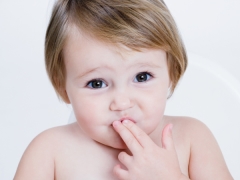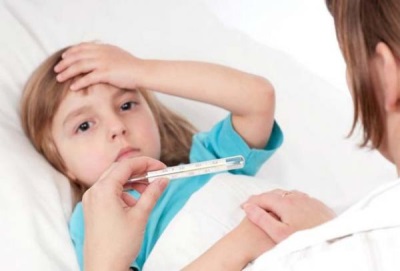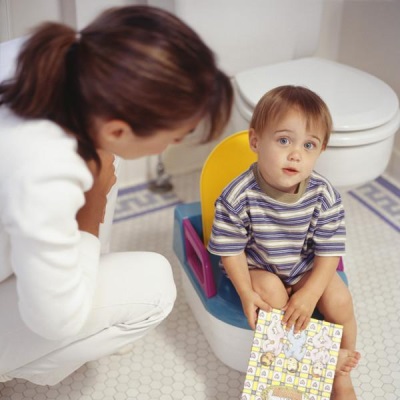Vomiting in a child without fever
When a child's temperature rises, liquid fecal matter is released and vomiting occurs, the most likely cause is an intestinal infection. However, the onset of vomiting is not always accompanied by such symptoms. What does vomiting without fever tell and how to act if a child has such an unpleasant symptom?
How does it manifest itself?
As a result of contraction of the muscles of the abdominal wall, stomach and diaphragm, the contents of the child’s digestive tract are ejected back through the mouth. Usually, this symptom is preceded by the appearance of nausea - the child has anxiety, the skin turns pale, the pulse quickens, and the limbs become cool to the touch. The contents of the stomach are often excreted with a sufficiently large head (such vomiting is called a “fountain”).
Selected masses are remnants of undigested food, may be with impurities, have an unpleasant smell.
What temperature is considered normal?
When measured in the axillary region, normal temperature indicators are considered up to 37.3 ° C, although in the first days after birth, the temperature of the infant may be slightly higher (up to 37.5 ° C).
Oral temperature of the child is normally from 36.6 ° C to 37.2 ° C, and measured in the rectum from 36.9 ° C to 38 ° C.
Symptoms and possible causes, what to do?
The most common causes of vomiting without a concomitant increase in temperature and stool changes are non-infectious diseases of the digestive tract and diseases of the nervous system.
Young children often experience functional vomiting caused by intolerance to certain foods or overeating. As a rule, with such vomiting, the state is not disturbed, and it itself is single.
Cause | How manifest | What should be done |
Pilorospasm | Scattered periodic vomiting, low body mass | Turning to a pediatrician, it is necessary to choose a special mixture that will establish the function of the gatekeeper |
Pyloric stenosis | The appearance of vomiting in the first days of life (it appears approximately 15 minutes after each feeding, the secreted masses are undigested milk), severe weight loss, dry skin, retraction of the fontan | An urgent need to contact the surgeon, as the treatment requires surgery |
Bowel invagination | The onset of attacks of abdominal pain, restless behavior of the child, weakness, vomiting, pale skin, later the appearance of a chair with mucus | The child should be immediately shown to the surgeon, since this pathology is very dangerous and is treated promptly. |
Repeated episodes of vomiting, sleep and appetite disturbances, severe abdominal pain, the child's body temperature may rise slightly, and in some cases remain within the normal range. | Immediately call an ambulance to help the child as soon as possible and prevent peritonitis. | |
Acute gastritiscaused by eating disorders or taking medication | Nausea and frequent vomiting eaten with bile | The child must be shown to a gastroenterologist and to comply with its instructions. |
Foreign body in the esophagus | The appearance of vomiting without other symptoms of the disease, while in the secreted masses may be mucus and blood, breathing problems may occur | Urgently call a child's doctor to prevent choking or rupture of the esophagus |
Brain damage | Episodes of vomiting that do not bring relief, weakness, drowsiness, anxiety of the baby, sometimes impaired pulse or breathing | The child should be shown to the neurologist to clarify the pathology and the appointment of the desired treatment. |
Action of psychogenic factors | In addition to episodes of vomiting, other health problems are not noted. | If the child has vomiting during anxiety, fear, force-feeding, or other psychological reasons, it is important to calm the baby, provide him with a comfortable environment, and consult with a psychologist. |
In addition, vomiting may occur in diseases of the pancreas or gallbladder. Pathologies of the endocrine system, in particular, adrenal cortex lesions and ketoacidosis in diabetes, also lead to vomiting without fever.
Without diarrhea
If vomiting attacks are not accompanied by abnormal stool, this indicates the absence of intestinal lesions. This clinical picture is characteristic of diseases of the upper digestive system (stomach, esophagus), central nervous system pathologies, endocrine diseases, poisonings.
In adolescent girls vomiting can manifest toxicosis during early pregnancy. Also in adolescent children, alcohol intoxication can cause vomiting.
With diarrhea
The appearance of loose stools some time after attacks of vomiting indicates food poisoning. Also vomiting without fever, but with the appearance of diarrhea, non-infectious diseases of the intestine can manifest.
Do I need to immediately call a doctor?
Almost always, when a vomiting attack occurs, it is worthwhile to promptly call a pediatrician, since it is important to quickly determine the cause of vomiting. It is possible to wait with the reference to the doctor only in the case of an undisturbed general condition of the child. If the crumb behaves as usual, his sleep is not disturbed, there are no other adverse symptoms, and the temperature has not increased, you can simply watch the baby. At the slightest suspicion of deterioration should seek medical help.
Immediately call an ambulance if the child:
- Indomitable vomiting, due to which the baby can not be drunk.
- Additional dangerous symptoms appeared - high fever, diluted stool, severe pain, impaired consciousness, delayed stool, convulsions, drowsiness, and others.
- Vomiting was preceded by the use of mushrooms or canned products.
- Before vomiting, the child took any medication.
- The child hit his head hard.
First aid policy
- If vomiting appears in the process of feeding, it is stopped, and the child is given a vertical position.
- Wash the child, then give a few sips of ordinary water to clean the mouth.
- If the child is lying, his head should be turned to the side. You can also raise it a little.
- Until the doctor arrived, you should immediately begin to feed the child in small portions. Give the baby alternately water and glucose-saline solution.
- It is impossible to give a baby any medicines, especially antibiotics, antiemetic drugs, a solution of potassium permanganate and painkillers, before the doctor examines the child. Such drugs can prevent the correct diagnosis and worsen the child's condition.
Treatment
The main nuance of vomiting treatment is the enhanced drinking regime of the child. Parents should pay maximum attention to breaking off the crumbs and preventing the development of dehydration. Any medication to give a child, the cause of vomiting which has not been established, it is impossible.
As soon as the doctor examines the baby and determines which symptom of the disease vomiting, he will prescribe a suitable treatment. For example, if a baby has any surgical pathology, it will be immediately sent for surgery. Identified neurological disorders will be a reason for further examination and treatment of the crumbs under the supervision of a neurologist.
Signs that treatment helps
Observing the doctor's instructions, parents should carefully monitor the child. We can assume that therapy helps if:
- The child’s well-being began to improve.
- Attacks of vomiting began to appear less frequently, and then stopped.
- The child behaves more actively.
- The baby has improved appetite.













